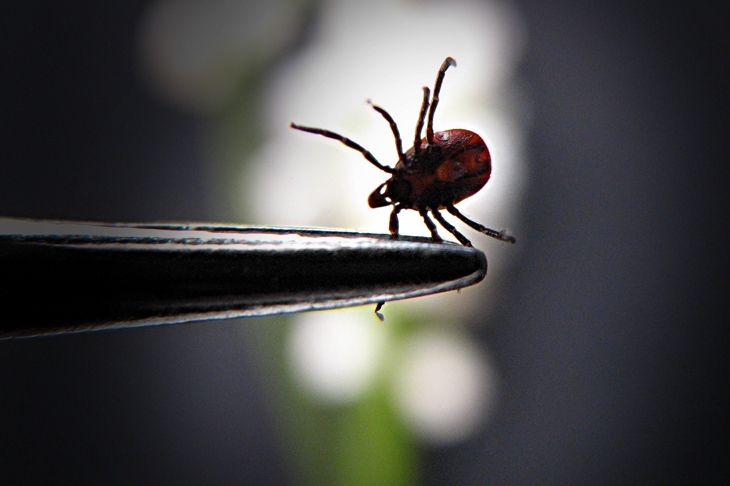Some medical experts claim that Lyme disease is worse than cancer. It’s not a competition, but I do know one thing: at least if you’ve got the Big C you get sympathy, understanding and prompt treatment. With Lyme you’re pretty much on your own.
This isn’t a plea for public sympathy. I’ve had Lyme for God knows how long — decades possibly — and though it has disrupted my health and my life in myriad weird, torturous and sometimes hideous ways, I still consider myself one of the fortunate ones. First, it hasn’t killed me; second, I’ve had some state-of-the-art stem cell treatment which with luck will eventually cure me. But it’s definitely not a condition I’d recommend.
It starts, as you probably know, with a bite from an infected tick. These are everywhere — the Scottish Highlands, the south coast, Richmond Park — and can be as tiny as a poppy seed. You’ve heard about the tell-tale ‘bullseye’ rash but this doesn’t always appear. Certainly, I don’t remember being bitten.
If you catch it early enough you can zap it with antibiotics (though usually with a heavier dose than the NHS is willing to prescribe). Any later than six months and you’re stuffed. Borrelia, the Lyme parasite, is a stealth microbe with a gift for burrowing itself into the deepest recesses of your system, eluding detection or interdiction.
Lyme disease is known as ‘the great imitator’ because it mimics so many disparate conditions, from rheumatoid arthritis, nerve pain, insomnia and chronic fatigue to (the one that has screwed me up most) psychosis. Every Lyme sufferer has the same experience: endless trips to the doctor with different problems continually misdiagnosed; friends and family members increasingly convinced that you’re the world’s worst hypochondriac; a growing sense of despair that this is never going to end — which is why the commonest form of death for Lyme victims is suicide.
Testing for Lyme is complicated and expensive. The basic Elisa test used by the NHS is useless because it produces so many false negatives. Once you’ve fallen at that hurdle, as likely you will, your doctor will lose interest. All over Britain — in fact, all over the world — are tens of thousands, perhaps hundreds of thousands, of Lyme victims languishing in their private hell, some so crippled they can’t even leave their bedrooms, and with no hope of a cure.
Why isn’t the medical profession all over this silent pandemic? A mixture of reasons: arrogance, ignorance and lack of resources. Despite the growing number of high-profile victims — George W. Bush, Kris Kristofferson, Kelly Osbourne, Daryl Hall, Oliver North, Ben Stiller, Avril Lavigne — woefully little is known about the disease or its effective treatment. But instead of admitting their ignorance, medics often double down by denying Lyme even exists, at least in its chronic form.
When I tried to raise money for my treatment via internet crowdfunding, I was a bit surprised to find myself attacked by various armchair experts as a con artist. ‘There’s no such thing as chronic Lyme,’ they claimed. Hmm. Try telling that to the dozens of long-term sufferers who’ve written to me in despair about the debilitating agonies — which come in waves, a bit like recurrent bouts of malaria — that have continued sometimes decades after they were bitten.
Because we’re self–interested and desperate, we victims acquire an expertise on Lyme way beyond that of most doctors. We know, for example, that it’s a cocktail of infections (not just Borrelia, but microbes such as Bartonella, Mycoplasma, Chlamydia, as well as the Epstein-Barr virus) which overwhelm the immune system in a way that individually they might not. We know it comes in roughly three-week cycles, usually announced by the arrival of a ‘brain fog’ which obliterates your power of concentration and makes you fear incipient Alzheimer’s. We know sugar makes it worse (the microbes feed on it) and that it can be alleviated with a host of wacky remedies, from Cistus tea to the Rife machine which kills micro-organisms with electromagnetic waves.
Lyme disease takes its name from Old Lyme, the town in Connecticut where in 1975 a cluster of adults and children began developing the characteristic symptoms. But the Borrelia microbe has been around much longer than that. It was even found in Ötzi, the 5,300-year-old mummy frozen in the ice of the Italian Alps. So the mystery remains: why only in recent decades has it become such a massive problem?
Various theories have been advanced, including, inevitably, ‘climate change’. My favourite concerns the one about Plum Island, just ten miles out at sea from Old Lyme, where scientists led by a Nazi called Erich Traub supposedly conducted post-war germ warfare experiments for the US military — including on weaponised ticks — at the notorious Lab 257. But the real reason, I suspect, is more prosaic than that and has something to do with the way our immune systems have been compromised by modern diet, lifestyles or environmental factors.
According to Bijan Boustani, the doctor who led my stem cell treatment at the Infusio clinic in Frankfurt, Lyme in its later stages assumes the characteristics of a chronic autoimmune disease. He treats it in the same way as cancer: boosting the body’s immune system so that effectively it can heal itself.
This makes sense to me. It explains why even though these ticks are everywhere, not everyone gets the disease. If your immune system is strong, you’ll fight it off. But if you’re weak and those microbes slip through your defences, that’s it: they swamp your whole system and you may never recover.
‘Why me?’ is a question I almost never ask, though. You play with the cards you’re dealt and there’s an end to it.







Comments